SOURCE:
No, those used vehicle exports are not all going to Mexico. On the contrary.
The number of vehicles of highway-legal light-duty vehicles in operation (VIO) in the US grew by 0.6% year-over-year, or by 1.6 million vehicles, to 284.4 million vehicles, at the end of the second quarter, according to Experian’s quarterly report today, based on registration data.
The net gain of 1.6 million vehicles in operation over the 12-month period is a result of:
- Added: 13.5 million new vehicles registered – down from about 17 million or more during a decent year, when supply chains were functional and vehicle production didn’t get waylaid by chip shortages.
- Removed: 11.9 million vehicles were taken out of operation, either by being salvaged; or by being exported to other countries. More on used-vehicle exports in a moment.
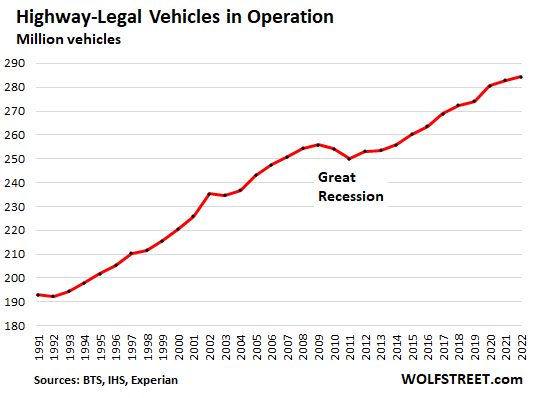
Used vehicle exports from the US to the rest of the world.
According to the Commerce Department’s International Trade Administration, 933,435 used vehicles were exported to other countries in the calendar year 2021, after the plunge in exports in 2020. In the data going back to 2008, the record was set in 2019, with exports of nearly 1 million used vehicles:
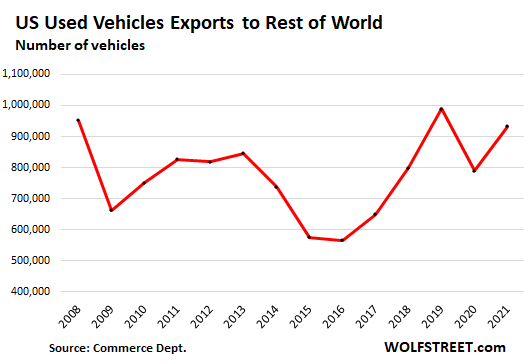
No, they’re not all going to Mexico. On the contrary.
Mexico has become an auto-manufacturing powerhouse. Some of the vehicles are built for export to the US and other countries. Other vehicles – often lower-priced models with fewer features – are built for sale in Mexico. These new vehicles built in Mexico for Mexico are feeding the used vehicle market in Mexico.
US exports of used vehicles to Mexico have declined over the years, from their heyday in 2014 of 110,000 vehicles to 66,800 vehicles in 2021, now representing only 7% of total used vehicle exports (red line in the chart below).
Among the top 10 destination countries in 2021 for used vehicles exports by the US is Germany where muscle cars have a presence, but only a tiny one, compared to the huge market of the country. But other countries on the list have small used-vehicle markets – such as the Dominican Republic or Lithuania – and US exports play are larger role in their local markets:
| Used Vehicle Exports, Top 10 Destinations | |
| United Arab Emirates | 109,715 |
| Nigeria | 108,014 |
| Ukraine | 106,489 |
| Georgia | 69,602 |
| Mexico | 66,848 |
| Dominican Rep. | 38,121 |
| Oman | 33,123 |
| Guatemala | 29,209 |
| Lithuania | 29,030 |
| Germany | 28,517 |
These are the top 10 destination countries of US used vehicle exports in 2021, and how those exports fared in prior years.
The UAE (top black line) has been one of the dominant destinations for US used vehicles throughout those years. Oman (yellow line) came out of nowhere to turn into the seventh largest destination over the past five years:
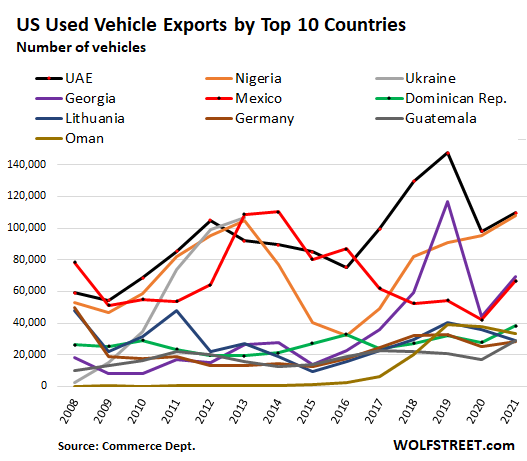
Vehicles in Operation by Automaker:
Of the 284.4 vehicles in operation, 21.6% were GM vehicles by Q2, same as in the prior year. Ford’s share dipped to 16.3% (from 16.4% in the prior year). Toyota’s share rose to 14.6% (from 14.5% in the prior year).
Tesla, which started mass-producing vehicles only over the past few years, still doesn’t have enough vehicles on the road in the US to figure into this table with its own name plate and is included in “Other manufacturers.”
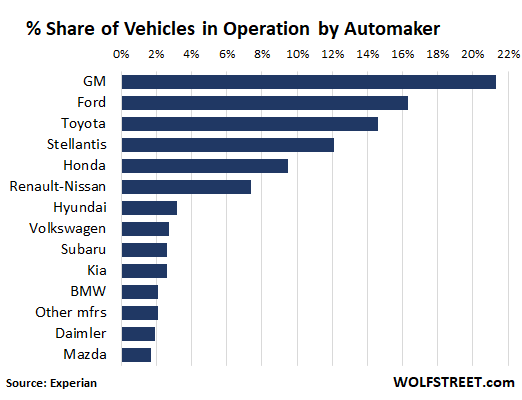
Battery-electric vehicles (EVs).
In terms of new vehicle sales, EVs are the one segment that is growing in leaps and bounds with huge percentage growth rates, even as sales of ICE vehicles have declined.
In California, where Teslas are made, EV sales made up 15% of total new-vehicle sales in the first half of 2022, up from a 9.5% share in 2021 and a 6.2% share in 2020.
And now that Teslas are made in Texas as well, it will be interesting to see how sales are going there.
But EVs are a recent development. In total, there are only 1.8 million EVs on the road, for a still minuscule share of 0.63% of the 284.4 million vehicles in operation. It will take many years of massive sales growth before EVs make up a significant portion of the total fleet on the road.
Segments of Vehicles in Operation.
Of the 284.4 million vehicles in operation, full-size pickups alone had the largest share of 16.3%, followed by mid-size cars – the mainstay of rental fleets – with a share of 14.1%. Overall, of all VIO:
- Passenger cars: 37.2%
- SUVs, compact SUVs, and crossovers: 36.1%
- Light trucks: 26.7%
For engine geeks.
Of the VIO with internal combustion engines:
- Naturally aspirated: 81.6%
- Turbo-charged (incl. multiple turbos), supercharged, and “other”: 18.4%
Cylinder market share:
- 4-cylinder: 42.6%
- 6-cylinder: 33.8%
- 8-cylinder: 20.9%
- Remainder: 2.7%. Vehicles with V-16, W-16, V-12, V-10, 5-cylinder, and 3-cylinder engines. Plus, some classics with 2-cylinder engines, including Trabi, Citroën 2CV, and Fiat 500 (not sure how many of them are “highway legal” tho).
Average age of vehicles in operation.
The average age of all cars and light trucks in operation in 2022 rose to a new record of 12.2 years, according to separate data, which I discussed in May when it came out.
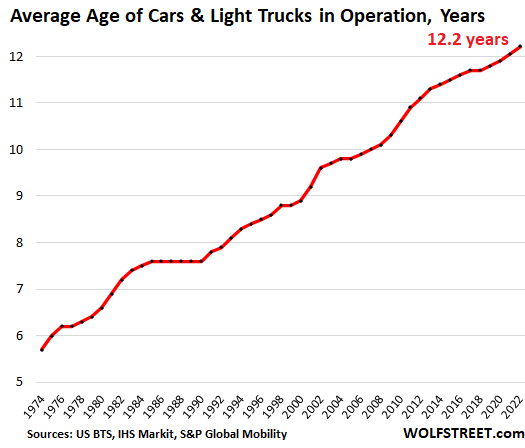
Miles driven.
Total miles driven, according the Federal Highway Administration, was up just a tad from 2019 levels, following the plunge in 2020 and the subsequent recovery. This includes all motor vehicle traffic, including commercial trucks and delivery vehicles. The chart shows the 12-month moving average to eliminate the large seasonal variations.
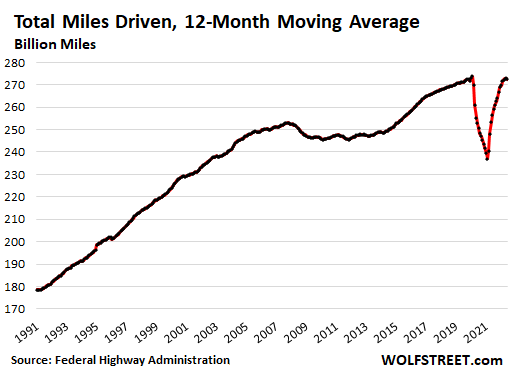




No comments:
Post a Comment
Note: Only a member of this blog may post a comment.